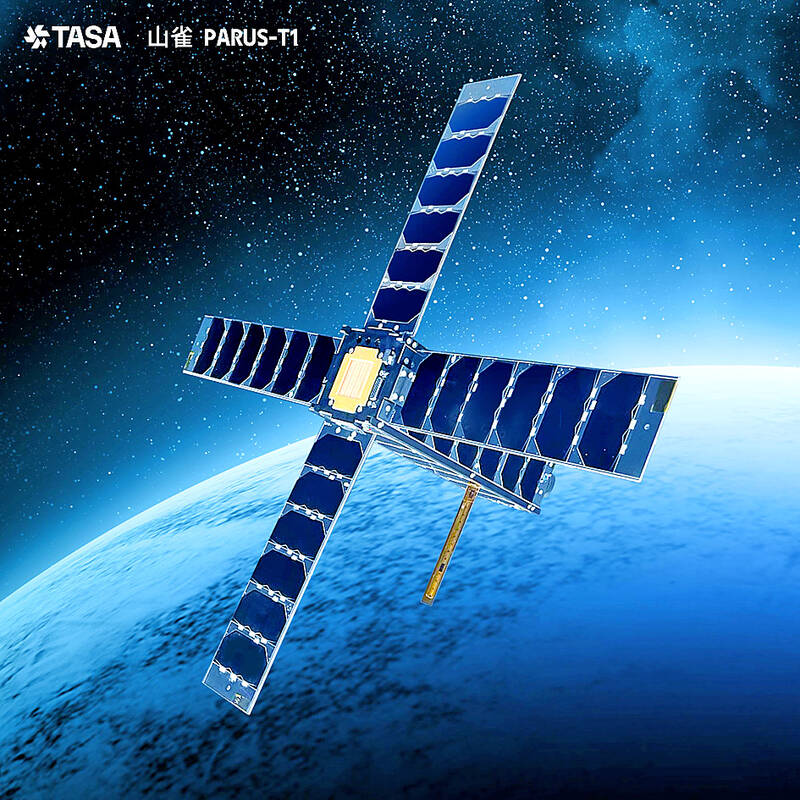Taiwan’s domestically developed PARUS-T1 satellite was launched into space yesterday on SpaceX’s Transporter-12 rocket from the US Vandenberg Space Force Base in California to begin its 12-month technological mission.
The rideshare mission was declared a success at 11:09am (7:05pm Pacific Standard Time on Tuesday), the Taiwan Space Agency (TASA) said.
The PARUS-T1 is a domestically designed, manufactured and integrated CubeSat-class 3U satellite launched to test the maturity of Taiwanese satellites, the agency said.

Photo courtesy of Taiwan Space Agency
It carried an experimental payload of telecommunications and systems to automatically identify ships.
The 3U-sized T1, T1A and T2 3U satellites and the 6U-sized T3 and T4 satellites share a common family of platforms developed under TASA’s PARUS program, it said.
Named after Sittiparus castaneoventris, a species of small birds endemic to Taiwan, the PARUS program’s aim is to develop compact and innovative satellite systems for the nation’s use, TASA said.
The SpaceX rocket deployed PARUS-T1 at an altitude of 515km in low Earth orbit 57 minutes after the launch, and the satellite deployed its solar panels and antenna 30 minutes after it entered orbit, it said.
PARUS-T1A, the PARUS T-1’s ill-lucked sibling, was lost in a failed launch of Space One’s KAIROS vehicle in Japan last month, TASA said.
Separately, the TASA and the Ministry of Environment yesterday unveiled a program to produce a constellation of air quality observation satellites to monitor air pollution over Taiwan, China and Southeast Asian nations.
The constellation would consist of four multispectral and hyperspectral device-equipped satellites to measure particulate matter smaller than 2.5 micrometers (PM2.5), carbon dioxide and methane concentrations, officials told a news conference in Taipei.
The NT$6.1 billion (US$184.49 million) research and development program — which is expected to put its first satellite in orbit in three years — is to be implemented from next year to 2031, the officials said.
In addition, the ministry is conducting a program to monitor air pollution over Kaohsiung and Pingtung County in collaboration with NASA and researchers from Taiwan and the US, they said.
The 3D air pollution monitoring program makes use of readings from ground-based stations, drones, aircraft and satellites to analyze the distribution of pollutants and improve predictive modeling, they said.
The ministry is also applying Internet of Things and generative artificial intelligence technologies to locate air pollution sources, they added.

Conflict with Taiwan could leave China with “massive economic disruption, catastrophic military losses, significant social unrest, and devastating sanctions,” a US think tank said in a report released on Monday. The German Marshall Fund released a report titled If China Attacks Taiwan: The Consequences for China of “Minor Conflict” and “Major War” Scenarios. The report details the “massive” economic, military, social and international costs to China in the event of a minor conflict or major war with Taiwan, estimating that the Chinese People’s Liberation Army (PLA) could sustain losses of more than half of its active-duty ground forces, including 100,000 troops. Understanding Chinese

The Ministry of Foreign Affairs (MOFA) yesterday said it is closely monitoring developments in Venezuela, and would continue to cooperate with democratic allies and work together for regional and global security, stability, and prosperity. The remarks came after the US on Saturday launched a series of airstrikes in Venezuela and kidnapped Venezuelan President Nicolas Maduro, who was later flown to New York along with his wife. The pair face US charges related to drug trafficking and alleged cooperation with gangs designated as terrorist organizations. Maduro has denied the allegations. The ministry said that it is closely monitoring the political and economic situation

UNRELENTING: China attempted cyberattacks on Taiwan’s critical infrastructure 2.63 million times per day last year, up from 1.23 million in 2023, the NSB said China’s cyberarmy has long engaged in cyberattacks against Taiwan’s critical infrastructure, employing diverse and evolving tactics, the National Security Bureau (NSB) said yesterday, adding that cyberattacks on critical energy infrastructure last year increased 10-fold compared with the previous year. The NSB yesterday released a report titled Analysis on China’s Cyber Threats to Taiwan’s Critical Infrastructure in 2025, outlining the number of cyberattacks, major tactics and hacker groups. Taiwan’s national intelligence community identified a large number of cybersecurity incidents last year, the bureau said in a statement. China’s cyberarmy last year launched an average of 2.63 million intrusion attempts per day targeting Taiwan’s critical

AGING: As of last month, people aged 65 or older accounted for 20.06 percent of the total population and the number of couples who got married fell by 18,685 from 2024 Taiwan has surpassed South Korea as the country least willing to have children, with an annual crude birthrate of 4.62 per 1,000 people, Ministry of the Interior data showed yesterday. The nation was previously ranked the second-lowest country in terms of total fertility rate, or the average number of children a woman has in her lifetime. However, South Korea’s fertility rate began to recover from 2023, with total fertility rate rising from 0.72 and estimated to reach 0.82 to 0.85 by last year, and the crude birthrate projected at 6.7 per 1,000 people. Japan’s crude birthrate was projected to fall below six,